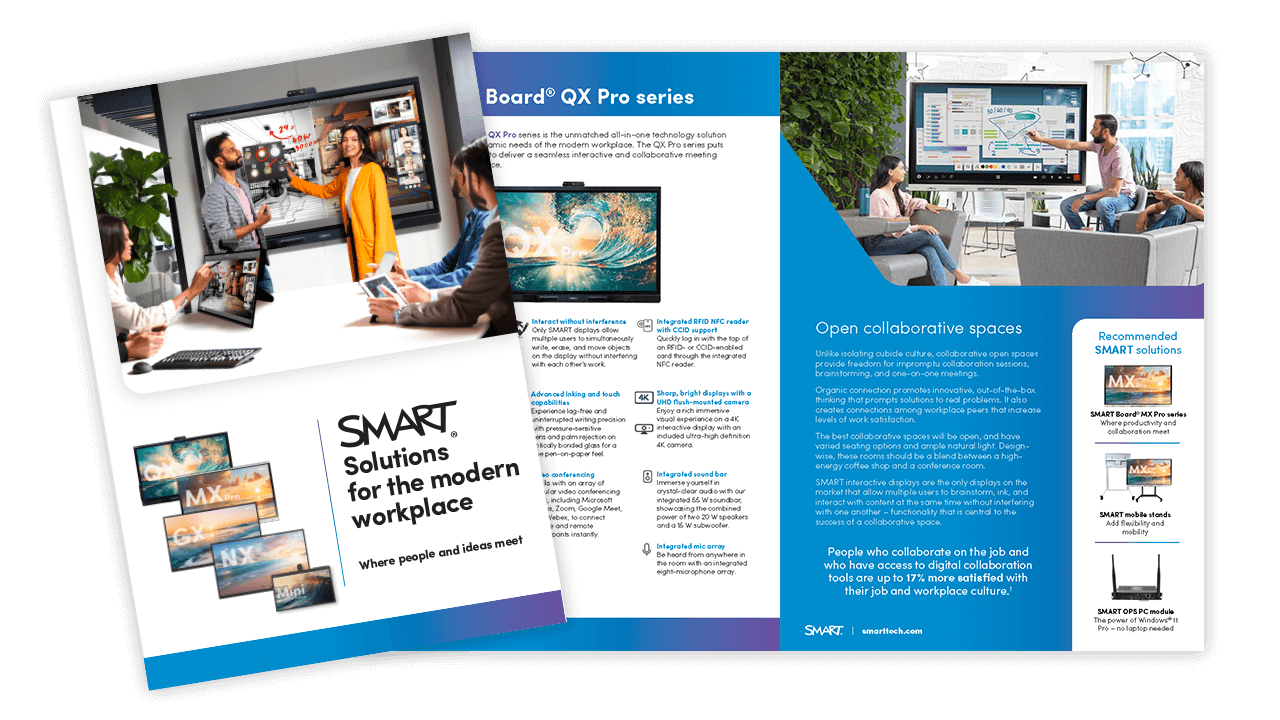Imagine a mission-critical decision being delayed because a team couldn’t effectively map out an evolving tactical scenario. Now imagine having the tools to ensure that that never happens again.
For government and defense agencies across the world, ensuring that people are properly trained and troops are deployed with all the skills they need to succeed in as little time as possible is critical. Recent technological advancements mean that – similar to most other industries – the days when training relied only on user manuals and in-person exercises are behind us. Today’s government workers, soldiers, and trainers can benefit from more collaborative, connected tech tools to learn the key skills they need to successfully execute plans and operations.
One of the best types of technology for enabling engaging, truly collaborative experiences are interactive displays: giant touchscreen devices that allow users to annotate and manipulate digital content using a dedicated pen or their hands. Rather than just giving another presentation or viewing static content on a TV, interactive displays enable users to deliver content that’s memorable because it’s more visual and interactive. Some interactive display providers, like SMART, are now providing TAA compliant solutions so that government, military, and other organizations can be sure that their technology enables truly secure collaboration.
But how specifically are interactive displays revolutionizing military training programs in organizations such as the US Army University and Defense Language Institute?
Mapping scenarios
Interactive displays have become essential tools for mapping and scenario planning. Instructors and senior officers can manipulate digital maps in real-time, zooming in on critical details or shifting to broader overviews of an operational area that wouldn’t be possible if using a physical map or a non-interactive TV. Since interactive displays utilize content taken from a personal device such as a laptop, users can also bring in other assets to complement tactical maps such as satellite imagery and additional notes.
This dynamic, visual approach makes it easier for recruits and soldiers to understand complex terrains, logistical routes, and potential points of interest in a way that traditional maps simply cannot match.
For scenario planning, interactive displays can simulate various strategic scenarios, helping teams to anticipate challenges and test responses to different situations. By overlaying potential enemy movements, weather changes, and other critical variables, these displays allow recruits to explore “what-if” scenarios in a controlled, visual format.
This capability to model multiple outcomes equips soldiers and planners with a deeper understanding of how decisions could play out on the ground, leading to more informed and effective strategic planning. In high-stakes environments, this flexibility and interactivity enhance situational awareness, allowing teams to make more responsive and data-driven decisions in both military training and real-world operations.
Technical diagrams made simple
The stakes are high when your military training program is teaching recruits to use technical equipment – misusing weaponry or failing to troubleshoot a broken communications array could be the difference between life and death out on the field.
Instead of using traditional static diagrams or showing a piece of equipment at the front of the classroom, instructors can present information on a high-quality display. Most interactive displays today come in sizes ranging from 55” to 86”, with 4K UHD resolution and 40W of sound output so that both images and videos can be seen by everyone.
Interactive displays also support hands-on learning through interactive walkthroughs, where users can engage with each part of the system and view step-by-step instructions or simulations of how components interact. For instance, when training on an aircraft or vehicle, soldiers can virtually dissect the machinery, examining engines, weapon systems, or control interfaces in a risk-free, digital environment. It’s even possible to use these displays with 3D modelling or CAD software for an even more hands-on experience. This approach enhances comprehension, allowing personnel to familiarize themselves quickly with critical systems and increasing readiness for field deployment or maintenance tasks before handling the real thing.
Operational efficiency
Operational efficiency is at the heart of any army base and the training center is no exception.
Digitizing resources and providing on-demand access to training content reduces the need for physical materials and printed manuals, which often need to be updated as new practices emerge. Interactive displays allow multiple recruits and soldiers to engage in strategic simulations as many times as they need without wasting resources.
Logistical efficiency is further improved as interactive displays streamline training schedules and resource management for instructors. Interactive training modules and scenarios can be quickly updated or customized for different skill levels, allowing multiple training groups to operate simultaneously on one base without requiring unique resources for each group.
The best interactive displays are also compatible with secure video conferencing solutions and can have equipment connected to them to facilitate remote or hybrid training. Soldiers on different bases can receive the same high-quality instruction without unnecessary relocation or coordination costs. This adaptability ensures that training remains flexible, consistent, and scalable across locations, enabling army bases to make the most of their available resources while maintaining high standards.
Secure collaboration and successful execution with SMART
See it, do it, teach it. Interactive displays can be – and are currently - used in every part of the training process to deliver training for defense agencies around the world. Whether it's mapping scenarios, explaining technical diagrams, or introducing a new standard operating procedure, there are many ways instructors can insert this equipment into their training centers.
It is crucial to note, however, that the interactive display you deploy on your base shouldn’t only come with all the features noted in this article but must also comply with the necessary secure technology standards.
The SMART Board® M Pro high secure series TAA is purpose built for secure environments:
- TAA compliant: Manufactured in North America with only trusted providers
- No unnecessary hardware: The M Pro high secure series TAA is deliberately built without an embedded mic-array, Bluetooth, or Wi-Fi so that you can add your trusted hardware as necessary
- Experience you can trust: SMART has spent over 35 years innovating the interactive space in a variety of industries. We work through most Government contracts including GSA, CHESS, ITES-3S COTS, 2GIT, FIRST Source, NIH, NASA SEWP V, and Canadian National Master Standing Offer (NMSO)/AVSO


